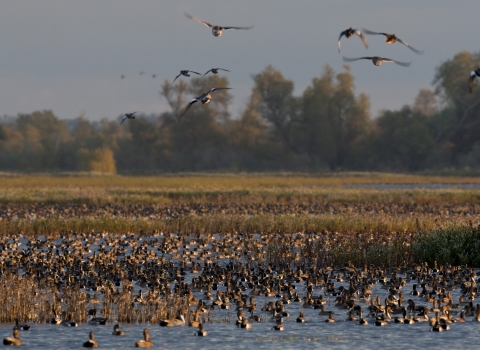Pollinators - butterflies, moths, bees, hummingbirds and other insects - play a crucial role in the production of most fruits and vegetables grown in Ohio. Many of these are summer favorites such as strawberries, peaches, apples, cucumbers, squash, tomatoes and watermelons. In the United States pollination by honey bees and other pollinators contributed to over $29 billion in crop production in 2010. Pollinators are also important in nature because only pollinated plants produce seeds, and these seeds will eventually produce new plants, providing food and habitat for a diverse array of wildlife.
Monarch butterflies are perhaps one of Ohio’s most recognizable and beloved pollinators. Monarchs travel 3,000 miles on their annual migration across North America, and occur in all 88 Ohio counties. Unfortunately, monarch populations have declined by 90 percent in recent years. Monarch caterpillars require milkweed plants for food, but many of these plants have disappeared.
Other pollinators are also in trouble. A recent study of the status of pollinators in North America by the National Academy of Sciences found that populations of honey bees and some wild pollinators are declining. Causes for declines are not well understood, but factors such as habitat loss and degradation, pesticide and herbicide use, and disease are likely contributors.
The importance of pollinators to both humans and wild places has been recognized at the highest levels. On May 19, 2015, The White House released the National Strategy to Promote Health of Honey Bees and Other Pollinators, and the U.S. Department of Agriculture has designated June 15-21 National Pollinator Week. Ohio Governor John Kasich recently signed a proclamation designating this week as Ohio Pollinator Week. The U.S. Fish and Wildlife Service and Ohio Department of Natural Resources Division of Wildlife are reaching out to Ohio’s landowners to help protect and restore pollinator populations. In addition, the Service has created the statewide Ohio Pollinator Habitat Initiative. The initiative works with partners such as Ohio Department of Natural Resources, Ohio Department of Transportation, The Ohio State University, and American Electric Power to expand and create pollinator habitat along right-of-ways.
There are many easy ways for you to brighten up your yard, increase the productivity of your vegetable garden, and promote pollinators during pollinator week and beyond:
- Pollinators need different food during different life stages. Add plants to your yard that provide food and habitat for caterpillars. Suggested trees and shrubs for Ohio include: dogwood, viburnum, redbud, sumac, hackberry, willow, birch, spicebush, sassafras, wild cherry, basswood, tulip tree, ash, oak, and pawpaw. Suggested flowers for Ohio include: violets, milkweed, black-eyed susan, columbine, ox-eye sunflower, smooth aster, shale-barren aster, joe-pye, rattlesnake-master, and Virginia mountain mint. Plant your garden with pollinator-friendly flowers that provide nectar for food throughout the growing season. Suggested plants for Ohio include: phlox, ironweed, goldenrod, aster, purple coneflower, blazing star, milkweed, viburnum, and blueberry.
- Avoid or minimize the use of pesticides and herbicides in your garden and on your lawn. If chemicals must be used, select a product that targets just your problem, follow the directions on the label exactly, and apply only to problem areas.
- Leave un-mowed areas along fence lines, streams, wet areas, roads, and other out of the way places. These patches of habitat provide homes for pollinators, and great pollinator plants, such as common milkweed, may grow.
- For assistance in planning and implementing a larger-scale pollinator habitat restoration, contact your local Ohio Department of Natural Resources, Division of Wildlife private lands biologist. For a list of contacts see: www.wildohio.gov For tips on conserving monarch butterflies, go tohttp://www.fws.gov/midwest/monarch/
For more information on pollinator conservation, see:
http://www.fws.gov/pollinators/
http://www.pollinator.org/
Backyards for Butterflies:
http://wildlife.ohiodnr.gov/portals/wildlife/pdfs/publications/information/pub089.pdf
Milkweeds & Monarchs:
http://wildlife.ohiodnr.gov/portals/wildlife/pdfs/publications/id%20guides/Milkweeds&Monarchs.pdf
Xerces Society for Invertebrate Conservation:
http://www.xerces.org/
Ohio State University Extension:
http://u.osu.edu/beelab/gardening-for-bees/


